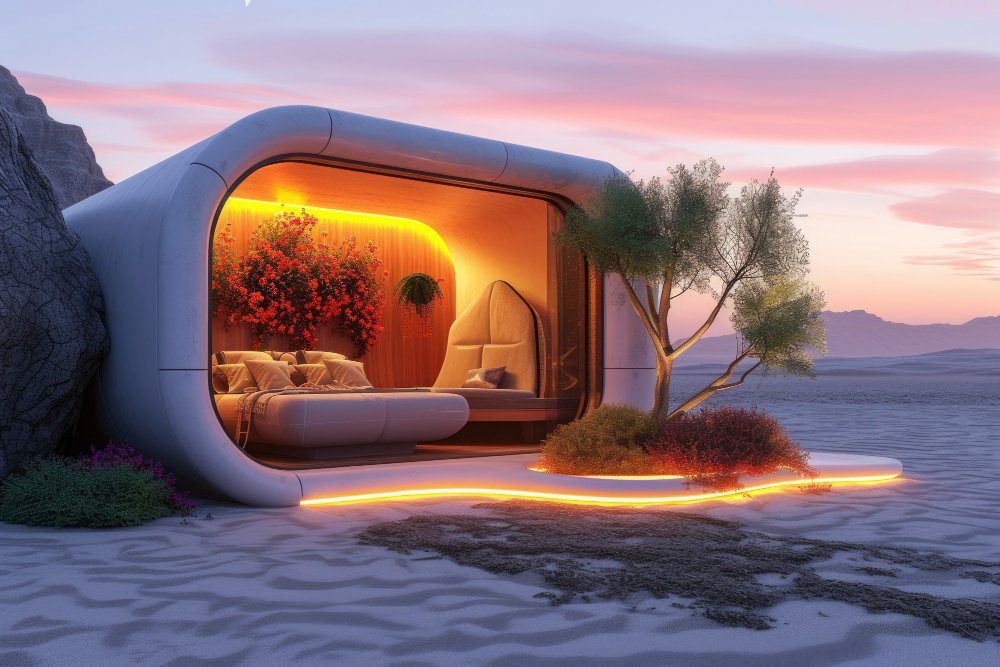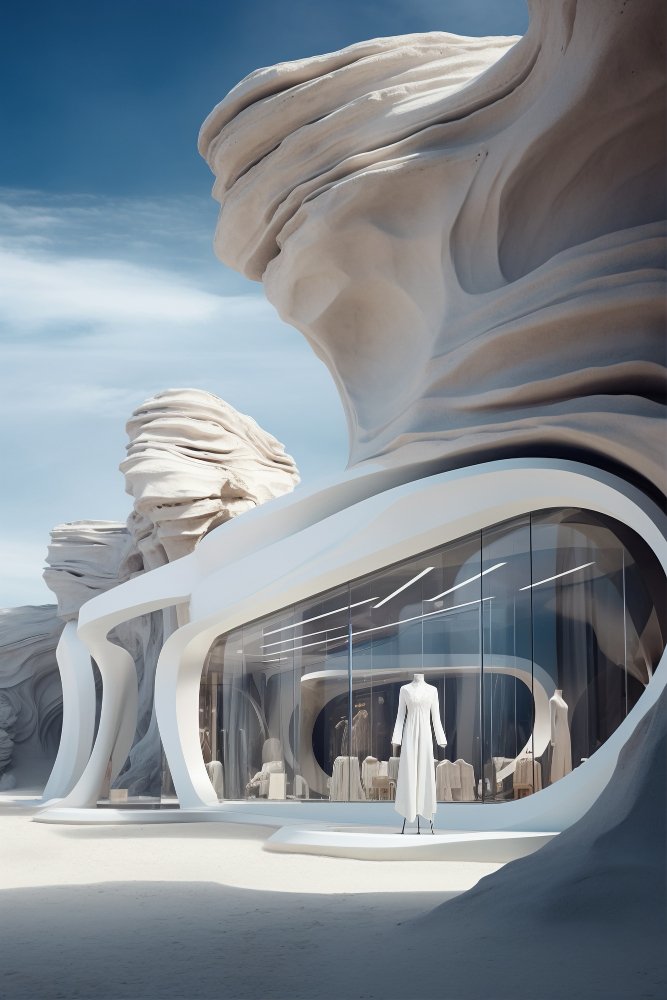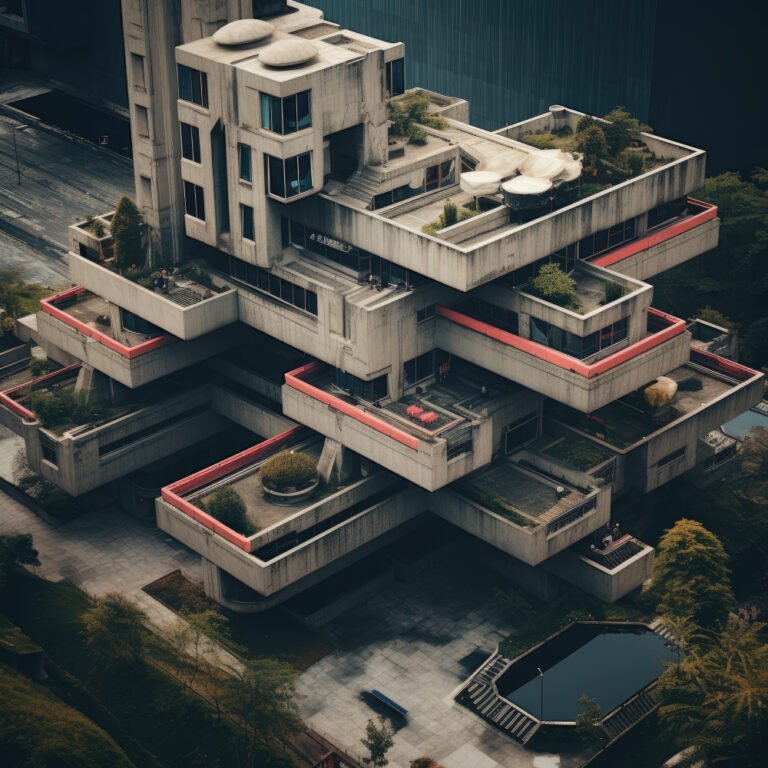7 Futuristic Homes Designed for Life on the Moon

Futuristic Homes: Designing a home for the Moon is not interior decorating with a lunar twist — it’s an exercise in architecture, materials science, robotics, life-support engineering, psychology, and law. As crews return to the lunar surface under Artemis and other national and commercial programs, architects and engineers are sketching homes that address vacuum, radiation, extreme thermal swings, lunar dust, and the logistics of hauling mass from Earth. This article presents seven futuristic Moon home concepts (from lava-tube shelters to 3D-printed regolith domes), explains how each solves core lunar problems, shows real demonstration programs and research that make them credible, and gives practical guidance for planners, architects, and enthusiasts preparing for human habitation of the Moon. Where helpful I link to recent research and demonstrations that underpin these concepts. ScienceDirect+4The Guardian+4NASA

Table of Contents
1. The design principles every Moon home must obey
Any credible Moon home design must explicitly address a short list of non-negotiable constraints:
- Radiation shielding: cosmic rays and solar particle events require mass or clever materials for acceptable dose rates (a few meters of regolith or equivalent). Research shows regolith shielding numbers and approaches. ScienceDirect
- Thermal stability & insulation: lunar day/night cycles (≈14 Earth days each) create huge temperature swings; active thermal control and insulation are essential.
- Micrometeoroid protection: habitats must resist small, high-velocity impacts or be quickly repairable.
- Dust management: lunar regolith is abrasive, electrostatically sticky, and corrosive — airlocks, dust traps, and suit-management systems are mandatory.
- Mass efficiency & ISRU usage: hauling mass from Earth is expensive; local materials and robotics must be part of the plan. NASA and other programs emphasize in-situ resource utilization (ISRU). NASA
- Autonomy and maintainability: remote maintenance windows and communications latency mean habitats must be robustly automated with local repair capability.
- Human factors: confined-space psychology, circadian cues, and communal design matter for long-term well-being.
With those constraints in mind, let’s survey seven home concepts that are already at prototype or technical-feasibility stage.
2. Home #1 — Lava-tube lofts: natural caves turned habitat
Concept: Use existing lunar lava tubes (subsurface voids formed by ancient volcanic flows) as the structural and radiation-shielding envelope. Convert an accessible lava tube into a multi-level living and working space with localized ingress/egress, internal partitioning, and engineered support structures.
Why it’s compelling: Lava tubes provide tens to hundreds of meters of natural rock cover — essentially built-in radiation shielding, micrometeorite protection, and thermal stability. Recent discoveries using LRO data and radar have highlighted accessible lava-tube pits and caves that could be candidate sites for bases. These natural shelters cut the need for large shielding mass to be launched or printed on-site. The Guardian
How it works (practicalities):
- Access via an entry pit (a “skylight”) with elevator or rover ramps.
- Install modular inflatable inner liners (to provide pressure retention, environmental control, and dust seals) anchored to the tube walls.
- Build interior decks for sleeping, labs, hydroponics, and storage; bury plumbing and power conduits in regolith trenches.
- Use the overburden for greenhouses where light can be channeled via fiber optics or surface mirrors.
Challenges: Structural stability must be characterized (rockfall risk), access points are limited, and exploration/robotic mapping is essential before human use. But when a structurally sound tube is found, it quickly becomes a top candidate for a first large habitat.
Real signals: LRO-derived lava-tube pits and published scientific surveys make lava-tube habitats an active research priority. The Guardian
3. Home #2 — Regolith-3D-printed domes (the sit-and-shield model)
Concept: Print structural shell(s) using local regolith feedstock, creating monolithic protective domes that house pressurized modules and working areas.
Why it’s compelling: 3D printing with simulated or real regolith has advanced quickly — NASA and university teams are developing regolith-based binders and composites that can be printed into bricks and structural elements. Using local dust removes the need to ship heavy shielding material from Earth. NASA’s “dust-powered” and regolith-composite printing demonstrations show feasibility. NASA Spinoff
How it works (practicalities):
- A foundation is prepared and a robotic printer deposits regolith composite layers to build a dome or shell.
- Interior volume is lined (polymer bladder + inflatable core) to hold pressure.
- The outer shell provides radiation and micrometeoroid protection; interior systems provide life-support, HVAC, and habitability.
Challenges: Achieving sufficient structural strength, durability in extreme thermal cycles, and dust tolerance of moving parts are active engineering topics. But regolith composites and polymer-enriched bricks are promising research directions. ScienceDirect
4. Home #3 — Inflatable + buried hybrids (expandables with regolith armor)
Concept: Ship compact, inflatable habitat modules (low launch volume, large on-site internal volume) and then bury them under regolith for shielding and thermal mass.
Why it’s compelling: Inflatable habitats (aka “expandables”) dramatically reduce payload volume while providing generous internal space once deployed — the Bigelow BEAM experiment on the ISS proved the concept in microgravity. On the Moon, the inflatable provides pressurized volume while a robotic regolith-covering operation piles material on top to meet radiation requirements. NASA
How it works (practicalities):
- Unpack and anchor the inflatable module; inflate and pressurize.
- Robotic excavators or rovers dump regolith over the module to a target depth (meters) to achieve radiation shielding.
- Install external access hatches and dust-lock airlocks for suits.
Challenges: The inflatable’s outer skin must resist abrasive dust and be repairable; burying and unburying for maintenance is nontrivial. But the combination of expandables + local shielding is an efficient first-base pattern.
5. Home #4 — Modular rover-mobile habitats (move where the resources are)
Concept: Modular pressurized modules mounted on mobility platforms — essentially habitat wagons that can reconfigure, cluster, and relocate to chase sunlight, water ice deposits, or safer terrain.
Why it’s compelling: The Moon’s resources (sunlight, subsurface ice) are unevenly distributed. Mobile habitats let small groups follow optimal conditions rather than being tied to a single static site. Mobility also aids exploration, rapid repair, and disaster avoidance (move before a large micrometeorite event or dust accumulation).
How it works (practicalities):
- Hab modules designed for structural connections and wheeled/skid transport.
- Docking mechanisms and automated handling robots connect modules into clusters.
- Mobility platforms include power and navigation systems; autonomy is essential for relocation.
Challenges: Mobility increases mechanical complexity, and moving heavy mass across regolith is energy-intensive. This model is most likely for small crews, forward scouts, or resource-gathering teams rather than large populations.
6. Home #5 — Subsurface tunnel villages (boring-based community networks)
Concept: Use surface-boring machines to create pressurized tunnel networks beneath the regolith, linking a string of chambers that serve as homes, farms, and workshops.
Why it’s compelling: Compared with single deep lava tubes (which are location dependent), bore-built subsurface tunnels create engineered, predictable shelters nearly anywhere. Tunnels combine regolith shielding with modular expansion possibilities and secure logistics corridors protected from dust and radiation.
How it works (practicalities):
- Deploy autonomous boring equipment that excavates and installs structural linings (3D-printed bricks, sintered regolith segments).
- Create nodes for habitation and shafts for ventilation, power, and access.
- Use modular robotics for maintenance and interior finishing.
Challenges: Boring machines must be highly reliable in abrasive regolith, and the energy cost to excavate is high — but once established, tunnels offer scalable, long-lived community infrastructure.
7. Home #6 — Greenhouse-centric biodomes (food-first living spaces)
Concept: Make the greenhouse the centerpiece: design habitats where plant production is both a life-support function and social/psychological focal point. These biodomes provide food, oxygen recycling, and calming green spaces for mental health.
Why it’s compelling: Plants deliver multiple mission benefits (food, oxygen, CO₂ scrubbing, psychological comfort). Growing plants directly in simulant regolith has been demonstrated in lab contexts (Arabidopsis and other crops), though growth is challenging and requires conditioning. Still, integrated biodomes can reduce resupply needs and support crew wellbeing. NASA
How it works (practicalities):
- Use hydroponics/vertical farming for staple calories and fast turnaround crops.
- Implement regolith-amendment beds for bulk crops after detoxification.
- Couple greenhouse to wastewater and nutrient recycling systems.
Challenges: Crop failure risk, high power demand for lights, and contamination control are real operational issues. But greenhouses are likely to be in every long-term habitat design.
8. Home #7 — Autonomous micro-habitat clusters (robot-built “plug-and-play” pods)
Concept: Small, factory-produced micro-habitat pods are robotic-deployed and self-connect into clusters that behave like modular apartments — minimal human installation required.
Why it’s compelling: Rapid expansion of a settlement requires a low-touch, fast-deploy method. Micro-pods optimize mass and volume for transport, and robotic orchestration reduces human labor. They pair well with commercial landers and can form the bones of a growing town.
How it works (practicalities):
- Pods are pretested on Earth, then landed autonomously.
- Rover crews connect power/data and assemble communal services (airlock hubs, greenhouses).
- Autonomous maintenance bots handle basic cleaning and repair.
Challenges: Standardization and robust plug-and-play interfaces are critical. Interoperability between vendors and operators must be agreed early to avoid stranded assets.
9. Construction methods & ISRU: how we’ll build them
A decisive trend in every credible Moon home plan is In-Situ Resource Utilization (ISRU) — using lunar regolith, water ice, and local volatiles to build, shield, and sustain habitats. NASA’s ISRU initiatives and pilot projects are explicitly focused on producing oxygen, water, and construction feedstocks on the Moon. NASA
Key construction methods:
- Regolith 3D printing: robotic printers deposit regolith composites into structural forms (domes, bricks). NASA spin-offs and academic work demonstrate regolith composites and printing approaches. NASA Spinoff
- Sintering / microwave heating: sinter regolith into structural tiles using concentrated solar or microwave energy.
- Inflatables + burial: ship light volume, then add local shielding. NASA
- Robotic assembly & modular docking: autonomous robots assemble prefabricated elements into larger complexes.
- Boring & subsurface excavation: tunnel networks and vaults created by robotic drills and lining systems.
The combination of these methods with robotics lowers the need for astronaut EVA workload and improves safety during the initial phases of base establishment.
10. Site selection: poles, equator, and lava-tube sweet spots
Where you place your Moon home depends on mission priorities:
- Polar regions (south more than north): Water ice in permanently shadowed regions is the prize for ISRU; near-pole peaks of near-eternal sunlight (peaks of eternal light) provide stable solar power options. These areas are first picks for resource extraction and long-lived bases. NASA
- Equatorial plains / mare regions: Easier landing logistics, historical exploration sites (Apollo) and abundant basaltic regolith useful for construction and sintering. Lava tubes (Marius Hills, Mare Tranquillitatis regions) are promising for protective habitats. TIME
- Lava tubes: If structurally sound and accessible, they offer immediate shelter and are arguably the lowest-mass way to achieve radiation protection.
Planners will weigh accessibility, resource availability, thermal and illumination regimes, and scientific value when picking sites.
11. Human factors: interiors, psychology, and culture on the Moon
Building the physical shell is the engineering half — designing interiors and social systems is the human half. Long-duration habitation on the Moon requires attention to:
- Circadian lighting: artificial day/night cues to maintain sleep and mood.
- Private space: individual privacy areas to reduce social friction in small crews.
- Green spaces & sensory variety: even small plant installations greatly boost morale.
- Work/leisure separation: clearly demarcated zones minimize role spillover.
- Habitability design for dust control: serviceable, modular surfaces that resist abrasive regolith.
Early Moon homes will likely blend efficient, functional shells with carefully curated interiors that support mental health — think modular personal cabins, communal kitchens, and shared recreational volumes.
12. Related-items / comparison table
| Home type | Primary advantage | Primary challenge | Best early use-case |
|---|---|---|---|
| Lava-tube lofts | Natural shielding & thermal stability | Structural assessment & access | Long-term base near known tube |
| 3D-printed domes | Uses local material; durable shell | Printer reliability & thermal cycling | First shielded surface habitats |
| Inflatable + buried | Low launch volume; large interior | Dust protection of exterior skin | Rapidly deployable initial modules |
| Rover-mobile habitats | Mobility to resources | Energy cost to move & mechanical complexity | Exploration teams / resource scouts |
| Subsurface tunnels | Scalable, engineered protection | High energy for excavation | Permanent community networks |
| Greenhouse biodomes | Food + psychological benefits | Power & crop failure risk | Crew nutrition and resilience |
| Micro-pod clusters | Fast expansion, modular | Standardization & docking | Commercial micro-settlements |
13. FAQs (6)
Q1: Are lava tubes really safe to live in on the Moon?
They’re among the best natural options for shielding but require careful geological study. LRO and other missions have identified pits and candidate tubes; follow-up robotic scouting is essential to assess stability and access. The Guardian
Q2: Can we really 3D-print strong structures from lunar regolith?
Early experiments and demonstrators — including NASA projects — show promising regolith composite prints and sintering approaches. Material science work is active; durability under thermal cycling and micrometeorite impacts needs more testing. NASA Spinoff
Q3: How will homes be shielded from radiation?
Main strategies: bury habitats under meters of regolith, use natural overburden (lava tubes), or add hydrogen-rich materials (water, polymer layers) as internal shielding. Research defines target mass depths for dose reduction. ScienceDirect
Q4: Do plants grow in lunar soil?
Lab tests demonstrated germination and some plant growth in lunar regolith samples, but growth is slow and stressful for plants. Regolith conditioning and combined hydroponic systems will be used initially. NASA
Q5: Will habitats be built by humans or robots?
Robotic pre-deployment is the most likely path: autonomy reduces astronaut risk and ensures infrastructure (power, shelter, ISRU) is ready when people arrive. Human crews then complete critical tasks and expand the base. NASA
Q6: How long before we actually live in these homes?
Timeline depends on policy, funding, and technical maturity. Artemis and commercial lunar plans aim for crewed missions in the 2020s–2030s; larger, semi-permanent habitats are plausible in the 2030s–2040s if ISRU and construction methods scale. Exact dates are uncertain but early demonstrations are already underway. NASA
14. Conclusion — pragmatic futurism: start small, cover big risks, and scale with ISRU & robots
The seven Moon home concepts above are not fantasy — they are practical answers to a fixed set of environmental challenges, and each maps to active research, demonstrations, or conceptual programs. Whether the first lunar residents live inside a lava tube, under a regolith-printed dome, or in a buried inflatable, three themes will govern success:
- Use local resources wherever possible — ISRU dramatically lowers mass and cost. NASA
- Automate construction and preparation — robots will build and test habitats before humans arrive. NASA Technical Reports Server
- Design for human health — radiation shielding, dust management, and psychological design are as important as structural engineering. ScienceDirect
If you’re an architect, policymaker, or space entrepreneur, the practical next steps are clear: invest in regolith construction materials, support lava-tube scouting missions, refine inflatable/semi-rigid interface tech, and prioritize human-centered habitat testing in analog stations on Earth. The Moon home of 2040 will be an engineered hybrid — a little geology, a little robotics, a lot of careful human design.






